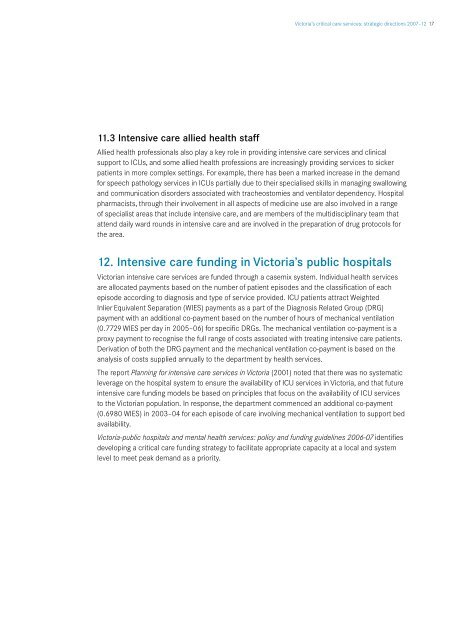Victoria's critical care services Strategic directions 2007–12
Victoria's critical care services Strategic directions 2007–12
Victoria's critical care services Strategic directions 2007–12
You also want an ePaper? Increase the reach of your titles
YUMPU automatically turns print PDFs into web optimized ePapers that Google loves.
Victoria’s <strong>critical</strong> <strong>care</strong> <strong>services</strong>: strategic <strong>directions</strong> <strong>2007–12</strong> 17<br />
11.3 Intensive <strong>care</strong> allied health staff<br />
Allied health professionals also play a key role in providing intensive <strong>care</strong> <strong>services</strong> and clinical<br />
support to ICUs, and some allied health professions are increasingly providing <strong>services</strong> to sicker<br />
patients in more complex settings. For example, there has been a marked increase in the demand<br />
for speech pathology <strong>services</strong> in ICUs partially due to their specialised skills in managing swallowing<br />
and communication disorders associated with tracheostomies and ventilator dependency. Hospital<br />
pharmacists, through their involvement in all aspects of medicine use are also involved in a range<br />
of specialist areas that include intensive <strong>care</strong>, and are members of the multidisciplinary team that<br />
attend daily ward rounds in intensive <strong>care</strong> and are involved in the preparation of drug protocols for<br />
the area.<br />
12. Intensive <strong>care</strong> funding in Victoria’s public hospitals<br />
Victorian intensive <strong>care</strong> <strong>services</strong> are funded through a casemix system. Individual health <strong>services</strong><br />
are allocated payments based on the number of patient episodes and the classification of each<br />
episode according to diagnosis and type of service provided. ICU patients attract Weighted<br />
Inlier Equivalent Separation (WIES) payments as a part of the Diagnosis Related Group (DRG)<br />
payment with an additional co-payment based on the number of hours of mechanical ventilation<br />
(0.7729 WIES per day in 2005–06) for specific DRGs. The mechanical ventilation co-payment is a<br />
proxy payment to recognise the full range of costs associated with treating intensive <strong>care</strong> patients.<br />
Derivation of both the DRG payment and the mechanical ventilation co-payment is based on the<br />
analysis of costs supplied annually to the department by health <strong>services</strong>.<br />
The report Planning for intensive <strong>care</strong> <strong>services</strong> in Victoria (2001) noted that there was no systematic<br />
leverage on the hospital system to ensure the availability of ICU <strong>services</strong> in Victoria, and that future<br />
intensive <strong>care</strong> funding models be based on principles that focus on the availability of ICU <strong>services</strong><br />
to the Victorian population. In response, the department commenced an additional co-payment<br />
(0.6980 WIES) in 2003–04 for each episode of <strong>care</strong> involving mechanical ventilation to support bed<br />
availability.<br />
Victoria-public hospitals and mental health <strong>services</strong>: policy and funding guidelines 2006-07 identifies<br />
developing a <strong>critical</strong> <strong>care</strong> funding strategy to facilitate appropriate capacity at a local and system<br />
level to meet peak demand as a priority.

















